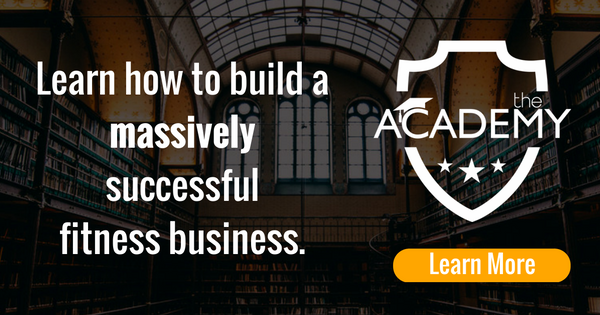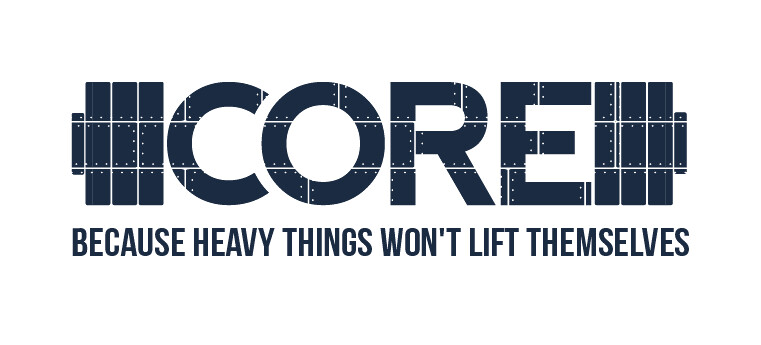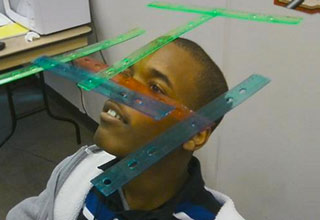A common fallacy in the fitness industry is that if you don’t own a gym you don’t have to worry about “business stuff.”
Another common fallacy are those who open a gym and automatically consider themselves businessmen (or women). The idea being because they open an impressive looking gym filled with all the bells and whistles, that all they have to do is turn on the lights and people will show up.

Ryan Ketchum chimes in today with an excellent article on the “fitness business” and how to build a successful one at that. I chime in too with some “TG Tidbits.”
His insanely reasonably priced resource The Academy is on sale now with tons of free bonuses.
Enjoy!
The Perfect Business Growth Plan
You didn’t go to business school and most the trainers I talk to don’t really have a passion for the business side of things. You’re in it to help people and create an impact.
Unfortunately there aren’t a lot of career options for trainers. You can work at a big box gym, maybe you get lucky and get a job working at a facility that provides you opportunities or you head out on your own.
So it’s no wonder that many great trainers end up frustrated with their business, struggling to get by or worse…
…end up leaving the industry.
Copyright: michaeljung / 123RF Stock Photo
You can’t SOLELY rely on your skills as a trainer to build your business. If you choose to start your own business you’re going to have to learn how to market, sell, and manage your business.
Fortunately there are 5 keys to ending your frustration and finding the success you want.
Step 1: Start With The End In Mind
If you don’t know why you’re doing something, the purpose behind it, it’s nearly impossible to get there.
Having a long term vision for your business helps you create a short term action plan that gives you purpose. When you have purpose you’re more motivated to take action.
Start by describing what you want your business to look like three years from now. Imagine writing an article about your business that’s going to be featured in your local paper or even something like Inc.
Tell the story of your business. How many clients do you have? How many team members? Locations? What are your values? What impact do you have the community? How are you innovating?
You don’t have to figure out how you’ll get there just yet. But, you need a clear picture of what it looks like when you arrive.
TG Tidbit: I remember when Eric, Pete, and I were drawing up the “plans” for Cressey Sports Performance back in 2007. The three of us huddled up at a table in a local Applebees and
tried not to destroy the back of our pantsdrew up a business plan and mission statement.I want to say the business plan was “don’t suck” and the mission statement was “make people into deadlifting X-Men,” but of course we were a bit more thorough than that. The point being: this had to be done. How else to draw a line from Point A (gym owner rookies) to Point B (WHOA – people are paying us)?
We had to write down our WHY and then how we were going to achieve it.
HINT: read Start With Why.
Step 2: Zoom In!
Once you’ve got a clear picture of where you want to be and what your business looks like in a few years it’s time to zoom in and focus.
This is what separates the dreamers from the achievers. It’s critical that you establish a 90 day plan.
At a minimum your plan should include:
- Revenue and profit goals
- Marketing goals
- Key projects/initiatives you’re going to complete
- A simple plan for hitting your marketing and sales goals
You can focus on hitting your goals and completing these projects over the next 90 days. It helps you set priorities and allows you to focus.
Copyright: dogfella / 123RF Stock Photo
If you accomplished 2-3 key projects or initiatives each quarter you’d have made progress in 8-12 areas of your business through the year! That’s huge progress, but you have to take it one quarter at a time.
TG Tidbit: When I opened CORE in 2015 this was something I admittedly struggled with. I still do. I’ve never been one to write down lists and then attack them. However, now that I’m starting a family it’s become more imperative I plan a head and recognize what needs to be done to best set myself and my family up long-term “success.”
Accountant? Check.
Financial Advisor? Check
Signing up for Jason Bourne hand-to-hand combat classes, which has nothing to do with nothing? Check
Finally understanding the power of list making and crossing things off? CHECK.
Step 3: Develop Your Marketing Strategy
If you’re going to grow to six figures and beyond you’ll need a strategy to acquire new clients.
Here’s where a lot of business owners go wrong! They deploy tactics with no consideration of an overall strategy.
Tactics are things like referrals, bring a friend days, FB marketing and joint ventures.They all work, but you need to know what you’re trying to accomplish and have a clear plan of attack before implementing these tactics.
A good business owner will understand their strategy and be great at implementing the right tactical methods to get them to their goals.
To start with your strategy let’s look at what you need to define:
- Your Core Offer – what are you building your business around?
- Your Ideal Client – who are you building around?
- Your Local Market Positioning™ – why they should choose you?
Once you have this the next step is to figure out what you’re trying to accomplish with your marketing. Defining the objectives of a marketing plan will help you create the right tactical plan to get the results you want.
Did you know that only about 3% of customers are ready to buy right now?
That means that for every 100 people who see your ads, fliers, social media posts and hear about you from your clients only 3 are ready to buy from you today.
But, what if you could educate and persuade those others?
Here are some sample objectives you can accomplish:
- Get people to trust you and your business
- Build credibility within the community
- Educate the market why they need to work with us
- Refer new business
- Gain respect
- Overcome price objections
- Gain influence
- Build urgency
Once you’ve created at least 3-5 objectives for your marketing plan it’s time to develop it.
Most fit pros get a majority of their leads from word of mouth marketing or referrals. And while you need that in your arsenal of marketing tactics it’s way too passive to grow an easy to run and fun business.
Because you’ll constantly be worried about getting referrals 🙂
If you choose to use an education based marketing approach you’ll be creating content that you can use to educate your target market that simultaneously sells your services.
TG Tidbit: Here’s where I lucked out. I started blogging in 2005-2006, when there weren’t that many people writing fitness blogs. As of today I have 1,875 posts on this site. That’s a metric shit ton1 of content.
Moral of the story: what are you waiting for? Stop procrastinating. WRITE! Building a brand isn’t going to build itself.
On an aside, I also think one of the often overlooked “keys” to marketing is to not look like you’re trying to market. There’s a lot to be said about authenticity and being genuine.
Determine what the biggest pain points are for your target market (this is why you need an Ideal Client profile) and create articles, videos and workshops covering these topics.
For most many trainers the primary goal for your clients is weight loss. Knowing that, what are the biggest concerns for someone that’s trying to lose weight but hasn’t had success?
Here’s a few ideas for content:
- How to eat if you want to lose 20lbs without following a strict diet
- How to get results with 30 minute workouts
- Eating Habits For a Lean Body
Quick Tip: You can get some really cool ideas from this Headline Generator.
Creating education based marketing on these topics will not only attract the other 97% (remember only 3% are ready to buy now) but it will also position you as the expert.
Once you’ve completed your education based marketing you can offer a solution for the biggest problem that your audience is facing. This is where you try to move a lead into your intro program.
Taking an education based marketing approach allows you to accomplish your primary marketing objectives.
If you’re stuck on tactical methods to get this strategy out to your audience here’s a quick list:
- Free e-books
- Workshops
- Seminars
- Lunch and Learns
- Videos
- Blog Posts
- Email Marketing
- Public Speaking
- Joint Ventures
- FB Marketing (ads to your videos/workshops/etc)
- Networking
Plus, when you educate your clients in your marketing they are more likely to refer their friends. And because you’ve educated them they know exactly what to say.
TG Tidbit: I had this conversation with a friend of mine the other day who started working in a commercial gym recently and has been having difficulty finding clients. I told her “why not set aside 30-60 minutes during your floor hours and provide a free “clinic” to members on topics you’re passionate about and will resonate? Topics like “Better Exercises Than Crunches to Build Your Core,” or “Fat Loss Myths,” or maybe provide a squat or Turkish get-up tutorial.
Get yourself in front of more people’s eyes, provide education (value), show them you’re an “expert,” and it’s likely someone interests will be piqued.
Step 4: Create Simple Systems
An easy and fun business doesn’t require you to do every single task. That actually sounds like a hard, lame business to run.
If you’re just starting out there’s going to be a short period where you’ll have to do it all. As long as the goal is to get non-revenue producing tasks off your plate as quickly as you can afford to that’s okay.
You need to create systems for the following:
- Lead Generation (marketing) Systems
- Conversion (sales) Systems
- Training Systems
- Customer Service Systems
- Billing Systems
- Accounting Systems
- Human Resources Systems
- Facility Management Systems
When creating your systems make sure you keep the 80/20 rule in mind. Knowing that 20% of your activities will produce 80% of your results will keep you focused on documenting the most important activities in your systems.
The rest can be up to the person completing the system. If you get all your systems to 80% and you hire the right people they can take it the rest of the way.
TG Tidbit: I’ll tell you right now, Pete Dupuis not only handled all the “business stuff” for CSP in the early days, but he also handled the calls, billing, scheduling, payments, and also helped handle cleaning duties (with everyone else). His life changed dramatically, though, the day we hired an office manager (see Step 5). However that wasn’t until three or four years into our business. The systems he developed prior were what helped him not go insane.
Step 5: Hire the Right People
Now that you’ve got your systems in place it’s time to look at hiring or outsourcing some of your tasks.
The first hires in your business should be a great accountant, a solid bookkeeper and a superstar admin.
Stacie Leary, the “face” of Cressey Sports Performance and who really runs the show…;o)
Unless you love staying up to date with tax code and spending countless hours getting your P&L ready a great accountant will save you tons of time and lots of money.
You want your accountant to do more than end of year tax prep. You want them doing your monthly P&L, cash flow statements and balance sheets. It’s also critical as your grow to have them help with tax planning so you don’t get behind or surprised with a huge tax bill on April 15th.
A bookkeeper will help you manage your expenses and work with your accountant to make sure everything is tracked correctly. My bookkeeper provided me with an accounts receivable and accounts payable report each week and I’d tell them what to pay and what to hold off on for our bills based on due dates and the cash we had available.
Hiring a bookkeeper saved me at least two hours a week doing stuff I hated!
Next you can look at hiring an admin to take on some of the work you’re doing that’s not revenue producing. Training, marketing and sales can stay on your plate for now but everything else if fair game to delegate to an admin.
Hiring trainers is a great idea once you have these other areas covered. That’s a tougher position to fill and requires more training on your part, which is why you do it after the other three.
Having an accountant, bookkeeper and admin frees up your time to train your trainer on your systems.
TG Tidbit: Having an accountant is HUGE. Especially one who’s familiar with the fitness industry and tax code (knowing what you can and cannot write off).
Also, in terms of hiring in general for your business….Hire PEOPLE not resumes.
Step 6: Know Your Numbers
Successful businesses don’t guess. They use data and information to make educated decisions.
That’s why you need to know your numbers. Tracking and reviewing a few numbers in your business will help you identify issues before they become a problem and help you make key decisions.
You need to be tracking the following weekly:
- Leads
- New Front End Offer Clients (people on your low barrier to entry offer)
- New Core Offer Clients (those signed up for your membership)
- Retention Rate
The following need to be tracked monthly:
- Operating Margin
- Autopay to Expense Ratio
- Closing Rate
- Growth Rate
If you can get this info you’ll be able to manage the health of your business and make better decisions on a weekly basis.
It’s not always fun setting things up so that you can get these numbers but it’s well worth it once you have it.
Wrap Up
You’ll be able to create a six figure strategy for your business by getting this in place. Don’t worry if you don’t have it all right now, or even if you don’t have any of it.
Start by making one of these a priority to get in place this month and then add a new one each month until they are all in place.
Not only will you be able to grow your business to six or multiple six figures quickly, but your business will be more fun and a lot easier to run.
You can get access to all the resources and training you need to build your own six figure personal training business in The Academy.
Give it a test drive and watch your business grow.













.svg/2000px-Facebook_New_Logo_(2015).svg.png)






